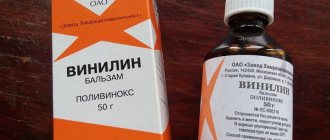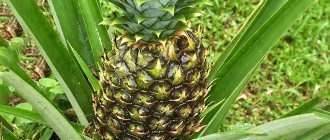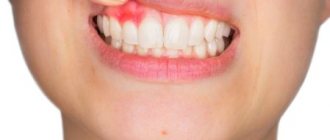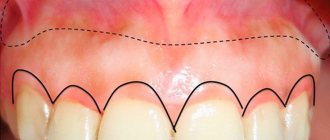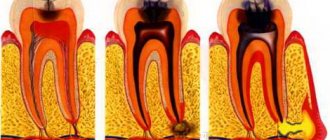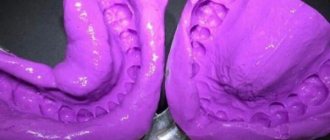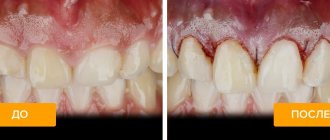Stomatitis is an inflammatory process of the oral mucosa, often of infectious or allergic origin. Stomatitis is one of the most common oral diseases in children of all ages, from infants to school-age children, although it can sometimes occur in adults. The special predisposition of children to this disease is explained by the fact that at a young age the mucous membrane of the oral cavity is more tender and thinner than in adults.
Types of stomatitis common in children?
Treatment of stomatitis will directly depend on the correct diagnosis of the form of the disease and the severity of its manifestation. Below are the forms of stomatitis that are most common in children.
- Herpetic stomatitis in a child is expressed by multiple small or merging blisters, gradually turning into erosions with a white-gray coating.
- Aphthous stomatitis in children is one, two or three elements of a round-shaped rash (aphtha) with a diameter of 5-10 mm with a red rim around.
- Candidal stomatitis in infants is a whitish “curdled” coating on the tongue or cheeks, tightly fused to the mucous membrane.
- Angular stomatitis , seizures - erosions with crusts in the corners of the mouth.
Children may also encounter toxic-allergic, bacterial, erosive, and many types of specific (arising against the background of a specific infection) stomatitis, but the most common are acute herpetic, chronic recurrent herpetic, chronic recurrent aphthous and angular stomatitis.
What is stomatitis?
Stomatitis is the general name for a large group of diseases of the oral mucosa, which are characterized by a general picture of inflammation, as well as the appearance of specific rash elements on the mucosa (depending on the type of stomatitis).
This disease can occur in both adults and children, with the only difference being that some types of “adult” stomatitis do not occur in children (prosthetic stomatitis or stomatitis associated with smoking).
What are the causes of stomatitis in children and infants?
In children and infants, in most cases, the cause of stomatitis is infection. Stomatitis is often associated with ARVI, although the virus is not directly involved in stomatitis.
Stomatitis occurs against the background of a decrease in general immunity, against the background of local immunity in the oral cavity, and can also occur due to injury and subsequent infection of the mucous membrane. With general diseases (acute respiratory infections, acute respiratory viral infections, severe systemic diseases), the body’s overall resistance decreases, which contributes to the development of stomatitis. With viral infections accompanied by a runny nose and cough, the oral mucosa dries out, resulting in a decrease in local resistance - this also contributes to the development of stomatitis.
Treatment
To rid a child of stomatitis, there is no one general method - each case is special and requires the help of specialists. During a complete examination of the oral cavity, the pediatric dentist in Minsk determines the type and stage of the disease, identifies the causes of its development, and also prescribes an individual course of treatment according to the age of your baby. Patients of the Family Dentistry Center know that timely treatment works wonders and even the most complex diseases and defects can be corrected if professionals are nearby.
As a rule, children are recommended special ointments and solutions, as well as medications to reduce fever or relieve pain. It is very important to follow the doctor's recommendations and help your baby, as well as monitor compliance with the rules of oral hygiene. With stomatitis, children need a special diet: soft, porridge-like food, always warm. It will be necessary to exclude citrus fruits and sour, sweet foods. After each meal, be sure to rinse your mouth with water.
You should not rely on folk remedies: remember, some herbal infusions and decoctions can cause a negative effect and also contribute to the development of an allergic reaction in children. Do not aggravate the situation, seek help from your dentist.
Herpetic stomatitis in children
Causes
This is an infectious stomatitis that occurs under the influence of the herpes virus. There are acute and chronic recurrent herpetic stomatitis. Acute herpetic stomatitis occurs when a child is first infected and occurs most often between the ages of 6 months and 3 years. In 100% of cases, the child gets the infection from parents and other close people (when they lick the child’s spoon and continue to feed him further, lick the pacifier or drink from the same cup). At this age, the child no longer has the antibodies that he gets from his mother’s milk, and has not yet developed his own. Therefore, when a virus enters the body, a disease inevitably begins. In its acute form, such an infection manifests itself in only 10% of children, and all the rest tolerate the primary infection quite easily.
Chronic recurrent stomatitis is due to the fact that the herpes virus, once entering the body, settles there forever and under favorable conditions (the above-mentioned decrease in immunity) can provoke repeated rashes.
The symptoms of acute and chronic herpetic stomatitis are different. In both forms, there are general phenomena (in the body as a whole) and a specific picture in the oral cavity.
Symptoms
Acute herpetic stomatitis
- General deterioration in health. Acute herpetic stomatitis is characterized by weakness, headache, pain in joints and muscles, malaise - general symptoms of intoxication caused by viral activity. The temperature is usually raised to 37 -41 degrees in the first or second day. The lymph nodes (especially the submandibular ones) enlarge and become painful.
In the oral cavity there are:
- swelling;
- redness of the mucous membrane;
- soreness of the mucous membrane in the cheeks, lips, tongue, palatine arches;
- small (the size of a millet grain) bubbles, usually collected in groups filled with a clear liquid; over time, the liquid becomes cloudy, and after 2-3 days the bubbles burst, and a bright red erosion forms in their place. Even later, the surface of the erosion becomes covered with a fibrinous coating (whitish or yellowish). These white spots are surrounded by a red corolla.
- Redness and swelling of the gum edge around the teeth and redness of the interdental papillae are often observed (clinic of gingivitis).
Along with rashes in the mouth, rashes are often observed at the border of the red border of the lips and skin or at the border of the nasal mucosa and skin.
Chronic herpetic stomatitis
All symptoms in the oral cavity repeat the picture of acute herpetic stomatitis, but the general condition, as a rule, does not suffer.
Factors that provoke exacerbations of chronic herpetic stomatitis:
- acute respiratory infections, acute respiratory viral infections, hypothermia;
- avitaminosis;
- allergy;
- stress;
- taking immunosuppressive drugs;
- exacerbation of chronic tonsillitis, sinusitis and other diseases;
- trauma to the oral mucosa;
- foci of infection in the oral cavity (carious teeth, hard and soft dental plaque, gingivitis);
- breathing through the mouth (due to this, drying out of the mucous membrane occurs, which provokes a decrease in local immunity, as well as the formation of cracks on the lips).
Treatment of herpetic stomatitis in a child
Be sure to consult a dentist for an accurate diagnosis. If it is not possible to see a doctor on the first day, you can start treatment, but a visit to the doctor as soon as possible is required.
Antiviral therapy (to combat the pathogen)
- Acyclovir (tablets) or Viferon (gel, suppositories) - depending on the age of the child. Suppositories are more suitable for infants and children up to one year old; older children can be given tablets or treated with gel.
- For rashes that are observed only on the skin, antiviral ointments are used (acyclovir, Viferon, Zovirax and others).
Antiviral drugs are taken according to the regimen specified in the instructions. The sooner you start taking the drug, the more active it will be against the virus. These drugs are taken on days 1-4 of the disease.
Antiseptic treatment (prevention of complications)
- Miramistin (rinse aid) is used directly as a rinse. For young children who cannot yet rinse their mouths themselves, wiping with a gauze swab dipped in a solution of the drug is used. Other antiseptics are either not used at all (since they are not effective against viruses), or are used in combination with miramistin (alternately). You can take chlorhexidine, givalex, rotokan, chlorophyllipt, but all this is only in combination with miramistin.
Keratoplasty (drugs to stimulate mucosal healing)
- solutions of vitamins A and E (you can buy an oil solution at the pharmacy). Applications are made after rinsing with an antiseptic (the drug is applied to a gauze turunda and the wound surface is lubricated).
- rosehip or sea buckthorn oil. Also in the form of applications.
- solcoseryl (after rinsing, apply a thin layer of gel using an ear stick or a clean finger).
One of these drugs to choose from.
Symptomatic treatment
- If soreness of the mucous membrane interferes with eating and hygiene - Dentol or its analogues (drugs used in children during teething) - lubricate the surface of erosions before eating or brushing teeth.
- If the temperature is above 38 degrees - paracetamol, nurofen, ibuprofen, mefenamic acid or any other antipyretics (according to the instructions).
- drinking plenty of fluids to reduce symptoms of intoxication;
- diet excluding spicy, salty, sour, hard foods, allergens (citrus fruits, chocolate, honey);
- Immunostimulants: imunal, amiksin, imudon and others - as prescribed by a doctor.
Chronic aphthous stomatitis
Causes
Aphthous stomatitis is caused by staphylococcus, a microorganism that is found in large quantities in dental plaque and lives in carious cavities. Every person has this microbe and usually does not manifest itself in any way, but against the background of immune disorders. Often aphthous stomatitis can develop against the background of allergies, gastrointestinal diseases or injuries to the oral mucosa. Another factor in the development of the disease is dirty hands. This disease is often associated with children putting unwashed toys into their mouths, thereby increasing the total number and variety of microbes in the mouth.
Symptoms
Most often, manifestations of chronic aphthous stomatitis occur on the lips, transitional fold, gums, under the tongue and on the tongue - in places where the mucous membrane can be injured by teeth or spicy food.
- Minor change in general health. Characterized by enlargement of the submandibular lymph nodes, fever and weakness.
- On an externally unchanged mucosa, aphtha appears - a spot 5-10 mm in size, slightly rising above the surface of the mucosa, covered with a whitish film tightly fused to the mucosa and surrounded by a bright red rim. Aphthae are very painful when touched. Most often there are one or two aphthae, less often – several.
Must remember! It is necessary to accurately determine the type of stomatitis: herpetic or aphthous. With herpetic stomatitis, there are many small blisters that turn into erosions and sometimes merge with each other, and rashes on the lips are possible. With aphthous rashes, larger, single rashes occur only in the mouth. If you have stomatitis, you should definitely consult a dentist to determine the type of stomatitis and choose the right treatment tactics.
Treatment
Elimination of the factor that caused the disease:
- exclude all allergens (citrus fruits, chocolate, brightly colored foods...);
- if you are taking medications that can cause allergies, then you also need to take this into account (tell your doctor what you are taking and for how long);
- exclude rough, spicy, salty, sour foods;
- if stomatitis is caused by allergies, antihistamines (suprastin, loratadine) are prescribed;
- If the aphthae is due to injuries from sharp edges of a tooth or filling, it is necessary to put the tooth in order.
- in the first 3-4 days, treatment of aphthae is carried out exclusively with antiseptics (rinses, gels). You can use chlorhexidine, rotokan, miramistin, givalex, stomatidine, listerine, chamomile and calendula decoctions - you can take any of these drugs (or any other analogue). Use according to the instructions (there are preparations in ready-made form, and there are those that need to be diluted). Rinse (or wipe the mucous membrane in small children) 3-4 times a day.
- after 3-4 days, epithelializing agents are added: solutions of vitamins A and E, rosehip or sea buckthorn oil, solcoseryl.
- If relapses occur frequently, you should pay attention to your general health. In some cases, only joint treatment with an immunologist, gastroenterologist, endocrinologist and other specialized specialists can help cope with the disease.
Must remember! Aphthous stomatitis is, first of all, a microbial lesion. Oral hygiene, adherence to personal hygiene rules, as well as timely treatment of caries, caries complications, and removal of tartar in many cases are sufficient to avoid aphthous stomatitis.
Who lives in the mouth and why?
We want to keep healthy teeth, always have fresh breath, of course “yes”. Then let's be friends with dentists.
A visit to the dentist is a frustrating problem for many. We understand this and want to help you overcome your fear and discuss your problems with you, assess the situation in your oral cavity, and offer treatment that is suitable for you.
Plaque is a good breeding ground for bacteria that destroy tooth enamel. Without removing hard and soft dental plaque, it is impossible to carry out full treatment, and choosing the color of the filling is complicated. For this we use the AIR-FLOW device and an ultrasonic scaler. If the patient regularly comes for cleaning, then unfavorable changes can be seen in time, and most importantly, measures can be taken in time. We can estimate the amount of plaque on teeth using a color test. Staining one third, and sometimes even 2/3 blue, tells the patient about a low level of oral hygiene. Helicobacter pillari is the causative agent of stomach ulcers. This is a proven fact. Helicobacter pillari remains viable in dental plaque and, with poor hygiene, can lead to recurrent gastric ulcers, even if the patient undergoes a course of antibiotic therapy. Because the bacteria in plaque and tartar are protected by biofilm. Our task is to suggest how to solve the “gaps” in hygiene. We remember those who are undergoing orthodontic treatment and wear braces. A common reason for visiting a dentist is “bad breath.”
1. REASON
- (general somatic) diabetes, chronic inflammation in the throat, tonsils, lungs, liver and stomach diseases
If you have healthy teeth that have been thoroughly cleaned, we recommend that you contact a therapist, gastroenterologist or endocrinologist to find the cause outside the dental clinic.
2.REASON -
local factors: teeth, tongue. mucous membrane, saliva.
In the area of tartar, food remains are retained and odorous microorganisms accumulate, and carious cavities, even if they do not hurt, turn into breeding grounds for bacteria.
3. REASON
— Drunk
4.REASON -
Eaten. Protein food, remaining between the teeth, smells bad due to the release of the smell of sulfur. Yogurt and curdled milk contain Lactobacillus bulgaricus, which cope well with this.
The culprits of caries, Streptococcus mutans, live in our mouths and feed on tiny pieces of carbohydrate food that stick to our teeth.
The fight: brushing your teeth 2 times a day (in the morning after breakfast, in the evening before bed).
Bacteria living in the mouth have a sweet tooth.
Struggle: limit yourself to sugars and “bad” carbohydrates. The main thing is proper nutrition.
Healthy foods for our teeth: cheese, cottage cheese, milk, meat, sea fish. Cabbage, carrots (especially raw), beets, onions, radishes, beans.
Make it a rule - don’t eat sweets at night.
Don't eat sweets as a last resort (dessert)
Avoid snacking on sweets between meals.
The necessary procedure to maintain the achieved level of health is a scheduled preventive appointment after 4-6 months.
Head of the dental department. Dentist-therapist Babenko Irina Ivanovna. General medical experience 25 years.
Candidal stomatitis in children (infants)
Cause
This type of stomatitis appears due to fungi, which are constantly present in the microflora of the oral cavity, but usually do not manifest themselves. Against the background of microflora disturbance (due to licking dirty toys, treatment of other diseases with antibiotics, acute respiratory infections, acute respiratory viral infections, during treatment with corticosteroids and other drugs that suppress the immune system, as well as with a high-carbohydrate diet), the growth of fungi of the genus Candida, which is the cause of stomatitis, is activated in infants.
Symptoms
- a whitish or yellowish cheesy coating on the tongue, cheeks, and gums, which is easily removed. It is important to remember that young children who are breastfed and whose diet is dominated by dairy products may have a coating of milk on their tongue - this is normal and does not need to be treated.
- when removing plaque, the mucous membrane is swollen, slightly red, and may be painful.
General health is usually unchanged.
When it becomes chronic, dryness and pain occur in the mucous membranes, and swallowing is difficult.
Treatment
- Candida mushrooms are well preserved in the external environment. It is necessary to wash all toys, bottles, dishes, pacifiers and other objects with which the child comes into contact with soap or soda.
- In the oral cavity, plaque is easily removed with a solution of soda (1 teaspoon of soda per glass of cold boiled water) - use a gauze swab to wipe the areas where there is plaque.
- Antiseptics (furacilin, decoctions of medicinal herbs, chlorhexidine) - rinsing or wiping the mucous membrane 3 times a day.
- Diet correction (exclude sweet, spicy, sour foods as much as possible).
- Local antifungal drugs (cholisal - spread on the mucous membrane 3 times a day after removing plaque, hexoral - dissolve a tablet (for children over 4 years old) and others). Carefully read the instructions for use and age restrictions.
- If improvement does not occur within 3-4 days, then you should consult a doctor to prescribe antifungal drugs for general treatment, as well as to identify possible concomitant pathologies.
Angular stomatitis in a child
Causes
In children, seizures are most often a manifestation of allergies, and can also appear while taking antibiotics. The mechanism is as follows: when using antibiotics, the microflora of the oral cavity is disrupted (both harmful and beneficial microbes die), against this background, space is freed up in which Candida fungi settle. It is these fungi that eventually cause the formation of buttocks.
Similar erosions can appear against the background of herpetic lesions, injuries, allergies, dry lips and cracks. It is important to determine the cause of their appearance and only then prescribe treatment.
Symptoms
Angular stomatitis (jams) - erosions with crusts that appear in the corners of the mouth - is also a fairly common form of stomatitis.
Treatment
- Antiseptics (chlorhexidine, miramistin) - use a gauze swab or ear stick to treat the surface of the wound.
- Keratoplasty (solcoseryl, oil solution of vitamins A and E) - applied to a dry surface after antiseptic treatment.
- Fighting the cause of the disease (if it is an allergy, we remove the allergens and prescribe antihistamines, if it is due to antibiotics, we prescribe drugs to restore the microflora and antifungal ointments, etc.).
Why do bacteria and germs cause oral diseases?
Even stable microflora of the oral cavity cannot be called completely safe. Thus, any damage to the mucous membrane or tooth enamel and subsequent inflammation contribute to the development of pathogenic processes. Even normal microflora can become unfriendly with weakened immunity.
The most dangerous are “alien bacteria”. They reproduce as a result of disruption of the normal functioning of the ecosystem. This phenomenon is common in periodontitis, caries, stomatitis, gingivitis and other diseases. The uncontrolled spread of bacteria, fungi and microbes leads to the release of toxins and the development of the inflammatory process. Often such microorganisms demonstrate a tendency to constant relapses, especially if therapy is not accompanied by restoration of the microflora.
Folk remedies
Traditional healers do not offer anything for the treatment of stomatitis in Samara : there are onions with garlic, and aloe, and a decoction of onion peels, and peroxide with water, and honey, and propolis and ... hundreds of other variations on the theme of anti-inflammatory substances. All this is very good, but does not exclude standard treatment, since all these substances act primarily on the consequences - on inflammation, but do not act on the pathogen. Rosehip and sea buckthorn oils are successfully used to heal erosions (the pharmacy equivalent is a solution of vitamins A and E), chamomile, aloe and other plants are used as antiseptics and anti-inflammatory, but their effect is rather weak.
The only thing that deserves attention:
- Rinse with raw egg white. 1 protein is dissolved in 100 ml. water and rinse with this solution (or lubricate the mucous membrane in infants). The protein contains a lot of lysozyme, which helps increase local immunity and helps fight infection. But the other side of the coin in this method is the danger of salmonella infection, so it is difficult to say whether it is worth the risk.
